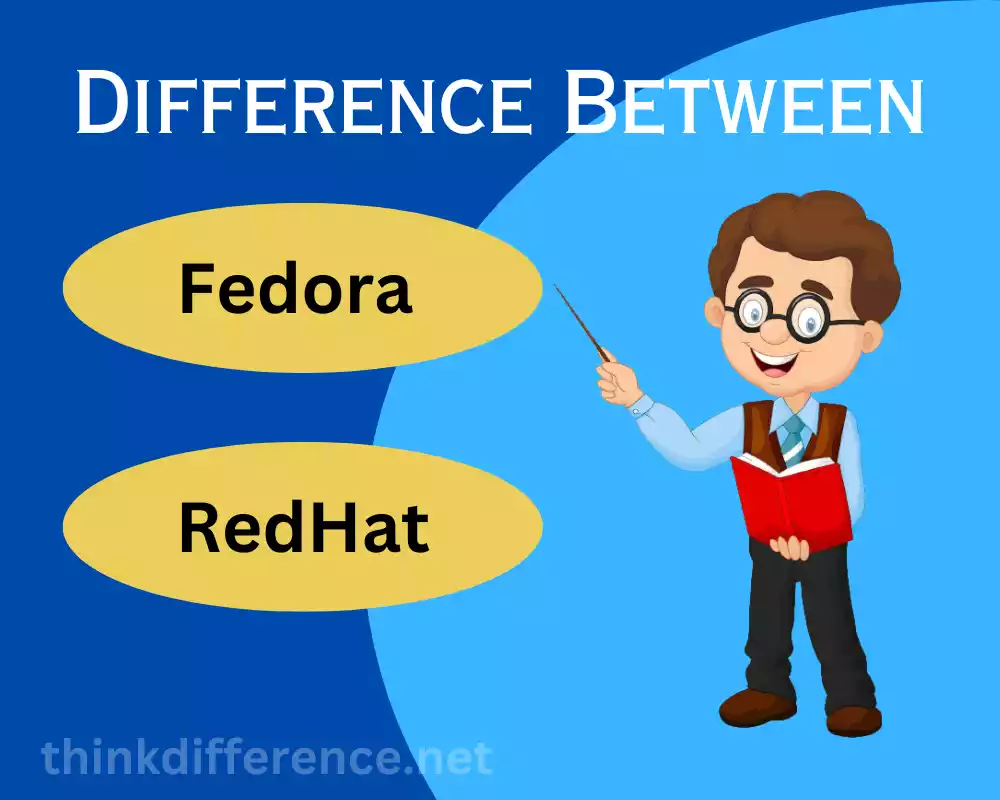Explanation of Fedora and RedHat
Fedora and Red Hat both utilize Linux for their operating systems but differ considerably in many respects. Here is an outline of both:
Fedora:
Fedora Linux distro, developed and maintained by Red Hat’s Fedora Project, offers users a user-friendly operating system featuring cutting-edge technologies and applications. Fedora features include:
- History and background: Fedora Linux first made its debut as the successor project to Red Hat Linux in 2003 and was intended as an open-source replacement to Red Hat Enterprise Linux for free and commercial deployments alike.
- Features and functionalities: Features and Functionalities of Fedora OS: Fedora is known for being focused on innovation, rapid developments, and adopting emerging technologies quickly. With over 44,000 software packages available and an abundance of libraries for development purposes – plus support for various desktop environments like GNOME KDE Xfce giving its users maximum flexibility –
- Target audience and use cases: Fedora provides users with a secure computing platform that meets these objectives head-on.
Fedora Linux is an attractive choice among enthusiasts, early adopters, and developers seeking the newest software features and applications. Ideal for desktop use as well as software development testing or experimentation purposes.
Red Hat:
Red Hat is the premier provider of enterprise software and services, including Red Hat Enterprise Linux – an enterprise Linux designed for security, stability, and long-term support. Here are a few key facts about this organization.
- History and background: Red Hat first established itself in 1993 as an open-source industry pioneer. RHEL serves as its flagship product and incorporates features and technologies from Fedora. Red Hat provides support and services through subscription models for enterprise customers.
- Features and functionalities: RHEL is a collection of features and functionalities that emphasize reliability, stability, and security. This operating system undergoes stringent testing, certification, and long-term support cycles before release to production environments. RHEL uses an established stack of software that prioritizes stability over cutting-edge features for deployment in mission-critical server deployment environments.
- Target audience and use cases: Red Hat Enterprise Linux (RHEL) is tailored for enterprise customers and businesses that demand reliable, secure systems with large-scale deployment capabilities; server environments; cloud computing; virtualization environments, or large-scale virtual machine deployment.
Fedora
Fedora, as previously discussed, is a Linux-based operating system developed and distributed by the Fedora Project Community under Red Hat sponsorship. Fedora ranks third most popular Linux OS behind Ubuntu and Mint respectively and uses RPM (like most distributions do) which makes for quick installation processes.

Fedora is a free, open-source operating system packed with software. Perfect for personal and home use. Updates typically go directly upstream which means any modifications would affect all Linux Distributions simultaneously.
Fedora typically has a short lifespan compared with some alternatives such as Ubuntu. Fedora releases new versions every six months, each supported for only 13 months – this can pose problems for product developers who prefer long-term support over having access to the latest version. But Fedora’s PowerPC support makes choosing Fedora an appealing proposition.
RedHat
Red Hat Linux was one of the more renowned UNIX-like operating systems produced by Red Hat until 2004 when its production ceased. Red Hat released version 1.0 back in 1994 under its former moniker of “Red Hat Commercial Linux”.

Red Hat Linux pioneered RPM Package Manager as a popular packaging format and its Anaconda installer has since been adopted by other Linux distributions. Red Hat introduced two tools for configuring its firewall called Lokkit and Kuduz; these enabled automatic hardware discovery and configuration, respectively.
Following Version 8, UTF-8 became the default character encoding. Native Posix Library support was later included. Red Hat set the precedent for other Linux distributions like Mandriva or Yellow Dog; Red Hat Linux 9 marked its final release before Red Hat Enterprise Linux became a separate project after 2004. Furthermore, Fedora Legacy Project provided updates for Red Hat 9 up until 2007.
Differences between Fedora and Red Hat
Fedora and Red Hat feature some key differences; here are a few:
1. License and Distribution Model:
- Fedora: Fedora is an open-source project developed through community participation. Anybody may use, modify and distribute it under GNU Public License and similar open source licenses.
- Red Hat: Red Hat Enterprise Linux’s commercial offering relies on a subscription model; users must buy subscriptions to gain access to official support as well as proprietary features.
2. Release Cycle and Updates:
- Fedora: Fedora releases new versions every six months with updates, bug fixes, and security patches distributed over approximately thirteen months.
- Red Hat: Red Hat uses an LTS model of support where Red Hat Enterprise Linux releases are supported for an extended period, typically 10 years or so. Red Hat prioritizes stability, security updates, and backported features during this support period.
3. Support and Stability:
- Fedora: Fedora provides community support via forums, mailing lists, and community documentation. As it’s rapidly developing it may be more prone to bugs or instabilities than other releases.
- Red Hat: Red Hat provides professional support services and technical assistance to users of its enterprise Linux distribution, Red Hat Enterprise Linux. Red Hat’s technical staff offers technical assistance, security updates, and bug fixes to ensure stability, reliability, and long-term support within enterprise environments.
4. Default Software Packages and Repositories:
- Fedora: Fedora provides access to open-source software packages of various varieties and versions from across different areas, giving its users access to cutting-edge features. Fedora distributes software via their project repositories.
- Red Hat: Enterprise Linux places stability and long-term maintenance ahead of new software releases, offering carefully chosen packages from its repository that cater specifically to RHEL users. Red Hat utilizes separate repositories from those provided by Fedora as part of this distribution method.
5. Target Audience and Use Cases:
- Fedora: Fedora caters to Linux enthusiasts, early adopters, and developers in search of cutting-edge features and updates suited for desktop use as well as software development testing or experimentation. It makes an ideal platform to explore all forms of creativity ranging from desktop use and software creation through testing to experimentation and test drives.
- Red Hat: Enterprise Linux (RHEL) is an enterprise Linux distribution designed for customers, companies, and organizations that rely on reliable, stable, secure operating systems to run mission-critical applications. RHEL excels at server deployment and virtualization while cloud computing and large enterprise environments may also utilize it.
Fedora shares much in common with Red Hat but tends to focus more on innovation, cutting-edge technologies, and community involvement than Red Hat Enterprise Linux does; its priority being stability with long-term support as well as enterprise features available via subscription-based models.
Similarities between Fedora and RedHat
Fedora and Red Hat both are built upon similar platforms and share many similarities that unite them both.

Below are a few key similarities between Fedora & Red Hat that you should know about:
1. Common Ancestry:
- Fedora: Fedora, sponsored by Red Hat, serves as an open-source project designed as an experimental ground where new technologies, software packages, and features may be tested before being added into Red Hat Enterprise Linux.
- Red Hat: Enterprise Linux was inspired by Fedora. As such, many core components, architectural decisions and software packages of Fedora remain present within Red Hat Enterprise Linux.
2. Collaboration and Contribution:
- Fedora: Fedora’s success can be traced back to a collective effort on the part of many developers, contributors, and users who actively take part in its testing, bug reports, documentation creation, and development processes.
- Red Hat: Red Hat’s participation in the Fedora development community benefits Red Hat Enterprise Linux as well as Fedora itself by sharing resources, expertise, and technological advances.
3. Open-Source Principles:
- Fedora: Fedora embraces the principles of free software by making its source code freely accessible, enabling its users to modify, distribute and contribute directly to its project.
- Red Hat: Red Hat Enterprise Linux was constructed using open-source technology and includes numerous open-source software applications. Red Hat actively participates in the open-source community by participating in various upstream initiatives and making contributions back.
4. Software Ecosystem:
- Fedora: Fedora provides users with multiple software packages and desktop environments, enabling them to tailor the experience according to their unique requirements and desires. This gives users greater customization.
- Red Hat: Red Hat Enterprise Linux offers an ecosystem of enterprise applications, frameworks, and development tools.
5. Focus on Security:
- Fedora: Fedora places great emphasis on security, including various features, practices, and updates about this matter. Regular security audits and vulnerability assessments as well as updates are conducted regularly by Fedora developers and included as standard practices in Fedora releases.
- Red Hat: Red Hat Enterprise Linux puts great emphasis on security with built-in features, thorough testing procedures, and access to security updates and patches to safeguard enterprise environments.
Fedora and Red Hat may differ in release cycles, support offerings, and target audiences, yet both share an enduring heritage, are committed to open-source principles, and prioritize security measures as crucial aspects for strength and reliability in each distribution.
Choosing between Fedora and Red Hat
Fedora or Red Hat may be the right option for you depending on your individual needs and requirements; this guide can assist in making an informed decision.
Purpose and Use Case:
- Fedora: Fedora will suit anyone from enthusiasts, developers, and early adopters seeking access to cutting-edge features and software updates alike. Offering an impressive variety of development tools and packages.
- Red Hat: Enterprise Linux (RHEL) is the ideal operating system if you require a reliable and secure platform suitable for mission-critical applications or large-scale deployment. RHEL features long-term support with robust security measures as well as industry certifications that make this an attractive option.
Support and Services:
- Fedora: Support is provided through mailing lists, forums, and documentation; Fedora does not receive official commercial support.
- Red Hat: Red Hat offers its active subscribers professional and technical assistance as part of their subscription agreement, as well as access to security patches, bugfixes, knowledge bases, and the expertise of its support staff.
Stability and Updates:
- Fedora: Fedora is an ever-evolving distribution that receives frequent updates and introduces new features rapidly, so that can lead to bugs or instabilities, and is not recommended as the basis of production systems.
- Red Hat: Red Hat Enterprise Linux places great emphasis on stability, reliability, and long-term customer support. Our rigorous testing and certification procedures help create an environment with maximum stability and security for our users, with updates designed to minimize disruption and maintain compatibility.
Software Selection:
- Fedora: Fedora provides users with the latest versions and technologies available today while offering various desktop environments, development tools, and applications – this may cause compatibility issues between older software versions.
- Red Hat: Enterprise Linux offers an exhaustively tested, conservative selection of software, placing more importance on stability and compatibility than on new software releases. As a result, this distribution makes an excellent fit for enterprise environments that demand uniform software stacks.
Licensing and Cost:
- Fedora: Fedora, an open-source software distribution, can be downloaded free of charge under various open-source licenses with no subscription or licensing costs associated with using it.
- Red Hat: Enterprise Linux requires an annual subscription. Subscriptions provide access to official support services as well as enterprise-grade features; their costs depend on the support level and a number of systems being run simultaneously.
Fedora or Red Hat? Your decision depends on your unique requirements. Fedora might fit better if you enjoy access to cutting-edge software in an interactive community setting; Red Hat Enterprise Linux should be chosen if stability, long-term support, and professional services for business needs are important elements to you.
Conclusion
Fedora and RedHat are two influential Linux distributions with distinct purposes. Fedora thrives on its cutting-edge features and vibrant community, appealing to developers and tech enthusiasts. On the other hand, RedHat’s stability, long-term support, and enterprise-grade solutions make it a preferred choice for businesses and organizations with mission-critical needs.
Both Fedora and RedHat contribute significantly to the open-source community, driving the progress of Linux as a whole. As technology continues to evolve, Fedora and RedHat will play essential roles in shaping the future of the Linux ecosystem.



